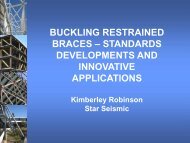Environmental Impacts of Multi-Storey Buildings Using Different ...
Environmental Impacts of Multi-Storey Buildings Using Different ...
Environmental Impacts of Multi-Storey Buildings Using Different ...
You also want an ePaper? Increase the reach of your titles
YUMPU automatically turns print PDFs into web optimized ePapers that Google loves.
- 10 -1 IntroductionThis report was produced for the Ministry <strong>of</strong> Agriculture and Forestry under the Request forProposal POR/7811.The 12-month collaborative research programme was directed by the Department <strong>of</strong> Civil andNatural Resources Engineering at the University <strong>of</strong> Canterbury, Christchurch.Scion (Wellington) was sub-contracted to undertake a substantial part <strong>of</strong> the research work,namely the Life Cycle Assessment and Green Star rating tool analysis.Acknowledgement <strong>of</strong> major contributions to the research programme is made to theUniversity <strong>of</strong> Canterbury, Scion and Victoria University <strong>of</strong> Wellington. Importantcontributions were made by many others including engineering and energy consultants,architects, quantity surveyors and construction project managers.All the Chapters in the report are written by the University <strong>of</strong> Canterbury, except Chapter 6,Life Cycle Assessment contributed by Scion.The report is structured as follows;Chapter 1Chapter 2Chapter 3Chapter 4Chapter 5Chapter 6Introduction.Executive Summary.A summary <strong>of</strong> the full programme <strong>of</strong> research, analyses, results, discussionsand conclusions.Background.Background information which positions the project and details goals andobjectives and the Research Team. This section also provides generalinformation about <strong>Multi</strong>-storey Timber <strong>Buildings</strong> and a significant combinedNZ Government and industry commitment to fund future relevant research.The <strong>Buildings</strong>.A key objective <strong>of</strong> the project was to design three buildings where the mainstructural components were either concrete, steel or timber. A fourth design,TimberPlus, maximising the use <strong>of</strong> timber throughout was also produced. Allbuildings have a projected 60 year lifetime.Operational Energy.A key objective <strong>of</strong> the project was to ensure that the four buildings were ‘lowenergy’ and designed to consume very similar operational energy over thelifetimes <strong>of</strong> the buildings.Life Cycle Assessment (LCA).Analysis and reporting by Scion. This chapter employs LCA to compare theenvironmental impacts <strong>of</strong> the four building designs, investigating the embodiedenergy <strong>of</strong> the various building materials and the building’s lifetime recurring(maintenance and refurbishment) embodied energy and associated operationalenergy. Two end-<strong>of</strong>-life scenarios are presented. The Global WarmingPotential (GWP) <strong>of</strong> each design is used to show differences between thebuildings due to the different materials used. A high level comparison ispresented between LCA and the NZ Green Building Council Green Star OfficeDesign rating tool.This chapter also includes the discussions and conclusions <strong>of</strong> Scion.
















